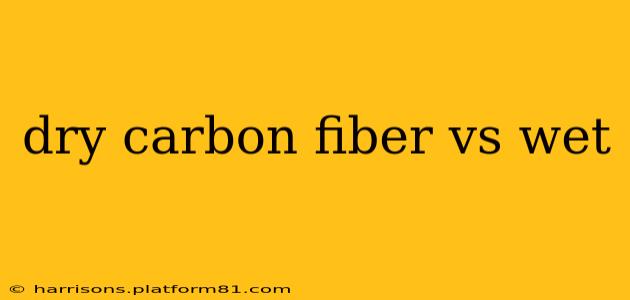Carbon fiber is a remarkable material renowned for its incredible strength-to-weight ratio, making it a favorite in high-performance applications like aerospace, automotive, and sporting goods. However, there are two primary methods of creating carbon fiber composites: dry and wet layup. Understanding the differences between these processes is crucial for selecting the right material for your specific needs. This detailed comparison will explore the key distinctions, advantages, and disadvantages of dry carbon fiber versus wet carbon fiber.
What is Dry Carbon Fiber?
Dry carbon fiber utilizes pre-impregnated carbon fiber sheets, often referred to as "prepreg." These sheets consist of carbon fibers already saturated with a precisely controlled amount of resin. The manufacturing process involves meticulously laying these prepreg sheets into a mold, often under vacuum pressure to eliminate air pockets and ensure proper fiber alignment. The cured composite is then heated in an autoclave under high pressure to fully cure the resin.
Advantages of Dry Carbon Fiber:
- Higher Fiber Volume Fraction: Dry layup techniques generally result in a higher concentration of carbon fibers within the composite, leading to increased strength and stiffness.
- Improved Mechanical Properties: The precise control over resin content in prepreg materials ensures consistent and superior mechanical properties throughout the composite.
- Better Surface Finish: Dry carbon fiber often exhibits a smoother, more consistent surface finish compared to wet layup, requiring less post-processing.
- Reproducibility: The pre-impregnated nature of prepreg makes it easier to achieve consistent results and replicate parts with high accuracy.
Disadvantages of Dry Carbon Fiber:
- Higher Cost: Prepreg materials are significantly more expensive than the raw materials used in wet layup.
- Specialized Equipment: Dry layup requires specialized equipment like autoclaves and vacuum bagging systems, increasing the overall manufacturing cost.
- Shorter Shelf Life: Prepreg materials have a limited shelf life, requiring careful storage and inventory management.
What is Wet Carbon Fiber?
Wet layup involves manually applying carbon fiber layers to a mold, followed by saturating these layers with liquid resin. This process is less precise and often involves more manual labor than dry layup. After the resin is applied, the component is usually cured at room temperature or in a low-pressure oven.
Advantages of Wet Carbon Fiber:
- Lower Cost: Wet layup is significantly less expensive than dry layup, making it accessible for smaller-scale projects and prototyping.
- Simpler Process: It requires less specialized equipment and can be done with simpler tools, reducing setup costs.
- Greater Design Flexibility: Wet layup allows for greater flexibility in design and the ability to incorporate complex shapes or customized features.
Disadvantages of Wet Carbon Fiber:
- Lower Fiber Volume Fraction: The imprecise nature of resin application often leads to a lower fiber volume fraction compared to dry layup, resulting in slightly reduced strength and stiffness.
- Inconsistent Mechanical Properties: The manual nature of the process can result in inconsistencies in the resin distribution and consequently, variable mechanical properties throughout the composite.
- Porosity: Air pockets can be more common in wet layup, reducing the overall strength and potentially leading to porosity issues.
- Rougher Surface Finish: Wet layup often yields a less smooth and less aesthetically pleasing surface finish than dry layup.
Dry Carbon Fiber vs. Wet Carbon Fiber: Which is Better?
The "better" method depends entirely on the specific application and priorities. Dry layup is ideal for high-performance applications demanding optimal strength, stiffness, and consistent quality, even if it comes at a higher cost. Wet layup is a more economical and flexible choice for prototyping, smaller projects, or applications where the highest possible mechanical properties aren't critical.
What are the different types of carbon fiber?
Several types of carbon fiber exist, varying in tensile strength, modulus, and other properties. These variations influence the choice between dry and wet layup, as the processing methods may be better suited to certain fiber types. The specific fiber type is usually selected based on the performance requirements of the final product.
How is carbon fiber made?
Carbon fiber production involves several stages, starting with the selection of precursor materials (often polyacrylonitrile), followed by spinning, oxidation, carbonization, and surface treatment. This process creates the individual carbon fibers, which are then bundled together into tows and used in both wet and dry layup processes.
What are the applications of dry and wet carbon fiber?
Dry carbon fiber is commonly used in aerospace components, high-performance automotive parts (like Formula 1 car bodies), and sporting goods where strength and lightness are paramount. Wet carbon fiber finds applications in smaller-scale projects, prototyping, and less demanding applications where cost is a major consideration. Examples include recreational boats, certain automotive trim pieces, and some sporting goods.
By carefully considering the advantages and disadvantages of each method and aligning them with the specific project requirements, engineers and designers can select the optimal carbon fiber layup technique to achieve the desired performance and cost-effectiveness.
